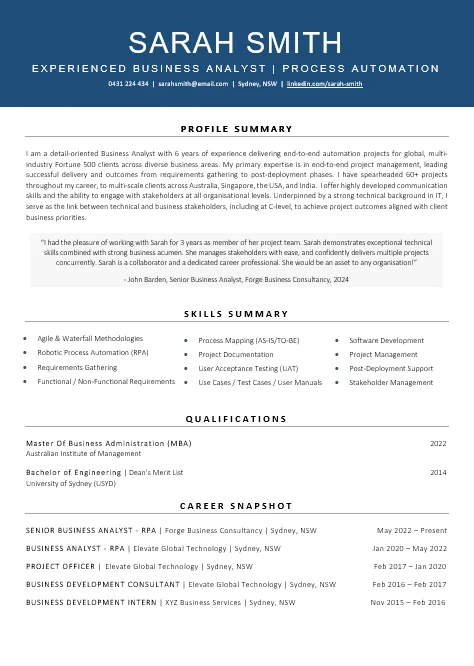Today’s job market is highly competitive and fierce. Regardless of how advanced and connected today’s world has become, employers still rely primarily on resumes throughout the hiring process to learn about candidates and determine if they might be a good fit for their company.
That said, crafting a standout resume can mean the difference between landing your ideal job or getting lost in the shuffle. Optimising your career prospects demands a CV that grabs attention and impactfully sells your unique value to a potential employer. At Elevate Career Services, we specialise in helping professionals like you craft premium, targeted resumes that secure high-quality interviews and transform your career prospects.
With our resume creation and career branding expertise, we understand what it takes to make your resume stand out in the competitive Australian job market. A resume is more than just a list of responsibilities and qualifications; it’s your personal marketing tool, built to sell your value to a potential employer by powerfully showcasing your results, capabilities, achievements, and unique value.
Our 10 resume crafting tips will equip you with the insights and strategies to craft a standout, effective resume that actually wins you interviews for the right roles. Whether you’re beginning from scratch or trying to improve your current resume, these tips will give you the information and skills to impress hiring managers and land those interviews.
1. Use a Professional Format and Design
Choose a professional format and a soft or standard font. Calibri, Arial, and Times New Roman are all suitable. There is no industry-wide standard, even if others will recommend using just sans serif fonts. The priority is to ensure the document is easy to scan and digest, i.e. that it doesn’t overwhelm the reader or make it difficult to find key information.
- Choose a font size between 10 and 12 points to make your resume legible enough without being too small.
- Use a single-column format with consistent formatting, bullet points, bold headings, and plenty of white space to enhance readability and clarity.
- Use the same structure and style throughout the resume format.
- Ensure sufficient spacing in the document borders and between bullet points or sections of text.
While they may look pleasant to the human eye, avoid using Canva resumes, images, tables, and graphics for the sake of both Applicant Tracking Systems (ATS) and the human reader (unless relevant to the position you are applying for, e.g. graphic design role). Images, charts, and other graphics can cause your content to become a garbled mess when it passes through the ATS.

2. Start with a Strong Summary
Start your resume with a compelling summary or profile outline to grab the employer’s attention. This summary is your ‘elevator pitch’ and should quickly communicate your value proposition in alignment with your target roles.
- Avoid outdated language focused on career goals or objectives. Focus on what you have to offer the employer, rather than what you want.
- Highlight your value proposition, effectively “selling” how you can fulfil the target role and meet the employer’s needs.
- Keep your summary to 4-8 lines, concisely outlining your career profile, experience, key skills, and unique value.
3. Highlight Your Key Achievements
A well-highlighted success makes your resume stand out by demonstrating your contributions, results, and value to the business. Achievements are the evidence of your capabilities, presenting a convincing argument for why you are a valued addition to a prospective company.
- Quantify Your Achievements:
Quantify your accomplishments where possible with clear, relevant metrics that demonstrate your activities’ impact. Use figures, percentages, or other tangible measurements to increase credibility and make your achievements more persuasive.
- Utilise Action Verbs:
Using action verbs will transform your resume from being passive to emanating a bold and confident tone, making your achievements more engaging and your first impression more memorable.
- Focus on Results:
Show how your contributions made a positive impact at your previous company by highlighting the results and outcomes of your hard work.
- Tailor Your Achievements to the Job:
Customise your CV for each application by matching your significant achievements with the job’s unique needs. Highlight experiences that are relevant to the position you are looking for.
- Show Career Progression:
Highlight increasing responsibilities, promotions, nominations for projects, and other initiatives you have partaken in. This indicates that your capacity and growth potential have been recognised by your past employers.
- Include Awards and Honours:
If you have earned any honours or accolades for your work, include them. This formal recognition of your efforts will increase your credibility and reveal to your superiors and peers that you have been acknowledged for your efforts.
4. Use Keywords from the Job Description
Many companies today, depending on the scale and industry, may use ATS to scan resumes for specific keywords and phrases. Aligning your CV with the job description improves your chances of being discovered, and also ensures the human reader can easily see your relevance and suitability. Use job-related keywords organically to demonstrate that you are an excellent match for the position.
Writing an ATS-compliant resume with relevant keywords will help you stand out among hundreds of other applications in the reader’s eyes as well! The best approach does not differ between the two.
- Review the job description and highlight relevant keywords that are a priority for the position. Check under key responsibilities or criteria, and mirror that language in your resume, if it falls within your scope.
- Match your qualifications and skill set by aligning to the hard and soft skills that are mentioned or themed throughout the job description. This includes specifics such as industry expertise, software systems, or technical skills.
- Be aware that potential employers will easily see what we call ‘keyword stuffing’ – a keyword-loaded resume that does not reflect your true ability for a specific job.
Our specialised team of career branding experts can assist you with this optimisation and guarantee that your resume meets the requirements for an ATS scan as well as for the human reader.
5. Showcase Your Skills
A well-written skills section will help your resume clearly and quickly demonstrate your relevance for the position. Use this skills profile to exhibit your most relevant skills to the specific role and its job requirements.
When crafting your resume, it’s important to understand the difference between hard skills and soft skills. Both skill types are valuable, but they serve different purposes in the workplace. Here’s an explanation of the distinction between hard and soft abilities, as well as how to effectively demonstrate them:
A. Hard Skills
Hard skills are specialised talents that can be taught and assessed, usually acquired through formal education and training or on-the-job experience. Examples of hard skills include programming, graphic design, and data analysis. These hard skills are frequently used to demonstrate your expertise in a certain field or to qualify for a specific job.
To demonstrate your hard skills:
- Be precise and show real instances of how you applied these skills in previous positions or projects.
- To illustrate your knowledge in these areas, share any certifications or training programmes you’ve completed.
- You may also identify any technical tools or software programmes you are familiar with.
B. Soft Skills
On the other hand, soft skills are characteristics that are frequently difficult to define or assess. These talents may include communication, collaboration, and leadership. Soft skills are typically seen as just as important as hard skills since they determine how well you collaborate with others and adapt to new situations.
To demonstrate your soft skills:
- Give examples of how you used them to achieve specific goals or overcome challenges by weaving them into your resume bullet points.
- Provide examples demonstrating your ability to interact with others, communicate effectively, and lead a team.
- You can also highlight soft talents in your cover letter or personal statement, which you can also use to describe your personal views and work ethic.

6. Include Relevant Experience Only
Ensure you are instantly relevant for the shortlist by focusing on relevant experiences only in your resume. Your target audience, the recruiter or hiring manager, is generally working on filling a very specific position or function within the organisation. Sell your relevant experience only to ensure your resume is concise, relevant, and effective in the initial candidate screening process.
- Your CV should highlight relevant employment experience and education.
- Align your experience bullet points with the job’s needs.
- Remove outdated or unrelated information.
- Harsh editing may be required, especially if you have an extensive career history.
- Showcase your most pertinent qualifications to stand out during initial screenings.
7. Proofread and Edit
Proofreading your resume is a critical mission to ensure there are no errors. Typos, misspellings, bad grammar, or even incorrect punctuation can sink your chances of even landing an interview.
The following tips will help you proofread your resume:
- Reread it very slowly. You need to slow down the reading process since our eyes are accustomed to absorbing chunks of text at once. You need to look at each word and each punctuation mark.
- Use editing tools. Tools like Grammarly can spot errors and suggest improving syntax. Avoid quickly accepting a suggestion. Inspect and decide whether the suggestion is appropriate.
- Check for any formatting problems. Bad choice of fonts, improper margins, poor spacing, and other design and formatting flaws can make even the most well-written resume look ugly.
- Pay close attention to not just how your document looks but also how it reads. You can use the ‘read aloud’ function in Word to hear your content and pick up on any minor issues that are difficult to visually pick up on.
- Have a professional review your resume. There may be writing problems you overlooked. An independent set of eyes—preferably an experienced editor is never a bad thing.
- Avoid using jargon or acronyms only (use extended forms first). The recruiter might not be an expert in your sector. If you make recruiters scratch their heads, you’ve already lost them.
- Verify your contact information. Double-check that your contact information, including phone number and email address, is correct. If employers are unable to contact you, your efforts will be in vain!
Your resume should be polished and clean and show you are attentive to detail and can produce professional documentation.
8. Tailor Your Resume to the Job
Tailor your resume to boost relevancy and reflect the exact job description. Doing so demonstrates that you have genuinely considered your suitability, and understand what the role requires.
Customising your resume goes a very long way in demonstrating to potential employers that you’ve invested thought and effort into your application, and have aligned yourself with their requirements. It projects you into the role and boosts your chances of securing an interview.
9. Include a Cover Letter
A one-page cover letter should accompany your CV as part of most job applications for the private sector (government is more complicated than this!). Its purpose is to provide the hiring manager with new information about your career story and profile and demonstrate your character. It gives a more complete picture of what you offer and should showcase any additional details on how your skill set aligns with the role, what you can bring to the team, and why you want the position.
Some hiring managers and employers will favour applications accompanied by a cover letter. Cover letters help to bring your application to life and help hiring managers form their first impression of you, so it is essential to include one in your application where the opportunity is there.
Provide a comprehensive understanding of who you are, provide context for your career journey, and showcase your enthusiasm for the role.
9. Include a Cover Letter
LinkedIn is an exceptionally powerful platform for job seeking when used well. Make sure your LinkedIn profile is up-to-date and consistent with the information on your CV. Many companies evaluate LinkedIn profiles during the recruiting process, so keeping your resume and LinkedIn accounts consistent will help you project a more professional and aligned picture.
An updated LinkedIn profile will boost your reputation and provide more a more holistic understanding of your career profile. Regular revisions and alignment with your CV improve your chances of creating a good impression on prospective employers, and help you get headhunted on the platform itself!

Gain Clarity and Confidence with Professional Resume Services
A well-crafted resume is transformational for career opportunities and trajectories. By following these ten tips, your resume will stand out and attract high-quality interviews and job offers. Download our FREE Ultimate Resume Writing Guide for further guidance.
Alternatively, for professional help from your own dedicated consultant, get in touch with Elevate Career Services and create a premium resume today. Our team is dedicated to elevating your career’s clarity and confidence. Invest in our expert career branding services to ensure your professional resume maximises your job search and lands you the highest quality career opportunities possible.







